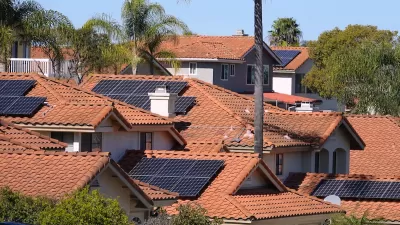The ecological impact of solar power plants is fueling a huge debate in the small rural town of Carissa Plains in California's coastal San Luis Obispo County, where the world's largest solar plants are being planned.
"But could this politically backed, popularly supported solar surge spiral into eco-disaster? That's what some say is happening to the Carrisa Plains, a sparsely populated swath of arid, sunny and relatively cheap land in eastern San Luis Obispo County, where three of the world's largest solar plants ever proposed are under review. Together, the Topaz Solar Farm, California Valley Solar Ranch (both photovoltaic projects) and the Carrizo Energy Solar Farm (a solar thermal operation) would provide energy to nearly 100,000 Golden State homes, but only by covering roughly 16 sq. mi. (41 sq km) of the ecologically sensitive plains with solar panels and industrial development. All three plants have deals with Pacific gas & Electric (PG&E) (which declined to comment for this story), and all want to start construction by the 2010 deadline for federal funds. And more solar-plant proposals are on the way, in large part because transmission lines with available capacity already run through the region."
"But it's not just annoyed neighbors and environmental attack dogs who are worried about these solar plants. John McKenzie is a planner for the County of San Luis Obispo, which is processing the applications for the photovoltaic projects. (The solar thermal project goes through the California Energy Commission.) 'There are a couple of pretty serious issues that need to be resolved,' he says, pointing specifically to the biological resources, water-supply concerns and agricultural protections that have to be evaluated before the county gives the go-ahead to the applicants. How much experience does he or anyone in the county have with these kinds of processes? 'Zero,' says McKenzie, a 20-year county-planning employee. 'These are the two biggest plants in the world ... This county is getting to be one of the first folks to deal with it.' Will any of these projects make it by 2010? 'There's a possibility,' he says, adding that the county is 'making a concerted effort to keep time frames down' but that there could be a 'whole slew of stumbling blocks.'"
FULL STORY: Solar Power: Eco-Friendly or Environmental Blight?

Planetizen Federal Action Tracker
A weekly monitor of how Trump’s orders and actions are impacting planners and planning in America.

Restaurant Patios Were a Pandemic Win — Why Were They so Hard to Keep?
Social distancing requirements and changes in travel patterns prompted cities to pilot new uses for street and sidewalk space. Then it got complicated.

Maui's Vacation Rental Debate Turns Ugly
Verbal attacks, misinformation campaigns and fistfights plague a high-stakes debate to convert thousands of vacation rentals into long-term housing.

Boulder Eliminates Parking Minimums Citywide
Officials estimate the cost of building a single underground parking space at up to $100,000.

Orange County, Florida Adopts Largest US “Sprawl Repair” Code
The ‘Orange Code’ seeks to rectify decades of sprawl-inducing, car-oriented development.

Maui's Vacation Rental Debate Turns Ugly
Verbal attacks, misinformation campaigns and fistfights plague a high-stakes debate to convert thousands of vacation rentals into long-term housing.
Urban Design for Planners 1: Software Tools
This six-course series explores essential urban design concepts using open source software and equips planners with the tools they need to participate fully in the urban design process.
Planning for Universal Design
Learn the tools for implementing Universal Design in planning regulations.
Heyer Gruel & Associates PA
JM Goldson LLC
Custer County Colorado
City of Camden Redevelopment Agency
City of Astoria
Transportation Research & Education Center (TREC) at Portland State University
Camden Redevelopment Agency
City of Claremont
Municipality of Princeton (NJ)




























